
The pay gap between men and women can improve when employers are more transparent about pay practices. Many companies are increasingly taking action to resolve gender pay gap issues. Discussing how wages and salaries are established and how pay raises and promotions are decided directly impacts the unconscious bias of those who determine compensation. Transparent pay practices can be extremely powerful for organizations. The gender pay gap persists even at the director and executive levels. Being open and honest about what is driving pay has the strongest impact on individual contributors, supervisors, and managers. Female executives still face discriminatory pay penalties for their gender. When employers use real market data and openly communicate with employees about their pay, it touches on the bias that directs compensation decisions. We must understand the challenges women face in the workplace and their role in eliminating biases.
Industry and Specific Positions
Male-dominated industries and occupations still have a gender pay gap, even in organizations with transparent pay practices. This is common in food preparation and serving, installation, maintenance and repair, production, protective services, and sales. Managers and HR departments must be trained to maintain an open mind and ongoing conversations with employees about compensation, using market data to show how pay was determined. Explain to your clients the importance of staffing liability insurance, as they must be protected from the things they can’t control or do not yet understand.
Pay-Equity Analysis
Gender pay gap and broad pay-equity analyses have been a positive step forward for many organizations. Remediation strategies to correct pay-gap issues and recruitment and hiring practices are being evaluated to determine decisions. Market pay data, performance management practices, paid time off, and flexibility benefits are examined for potential biases leading to pay disparities. Pay equity is one of the quickest growing topics in the HR profession, where organizations expand their understanding of potential bias or gaps that may exist, such as hiring and promotion. Performance management programs must comply with updated frameworks to be bias-free.
Learning and Development
Pay transparency is needed to establish an inclusive work environment. Transparent pay policies can help level out the gender pay gap, but unfortunately, jobs at the director and executive level still have pay equality issues. Women continue to be underrepresented in many positions and industries. Sometimes inadequate training and development are to blame. Training can help close the gender pay gaps as well as helping employees to develop skills like negotiation tactics, coaching, management, and self-promotion. These can make a huge impact in increasing female presence in leadership positions. Those in higher positions should better define equity pay gaps to reach pay equality across employees in similar positions and across levels. It is essential to look beyond simple salary comparisons and evaluate the recruitment process. Also, how are promotions and raises decided? It’s important to start asking the hard questions. Even though it may be uncomfortable, it all begins with transparency.
About World Wide Specialty Programs
For the last 50 years, World Wide Specialty Programs has dedicated itself to providing the optimal products and solutions for the staffing industry. As the only insurance firm to be an ASA commercial liability partner, we are committed to that partnership and committed to using our knowledge of the industry to provide staffing firms with the best possible coverage. For more information about Staffing Professional Liability Insurance or any other coverage, we have available to protect your staffing business, give us a call at (877) 256-0468 to speak with one of our representatives.


